let the objects speak
Lambayeque - Tunic Fragments
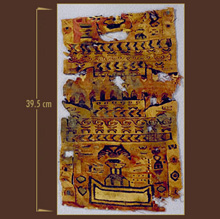
This is one of three substantial and colourful fragments that were all once part of a tunic, a sleeveless form of Andean shirt. It was woven sometime between A.D. 800 and 1300 in the Lambayeque style of Peru's northern coast. The Lambayeque people thrived during this time, establishing themselves as seafarers and long-distance traders. The Lambayeque occupied lands that were at more northerly latitudes than the other large polities in Peru. This positioned them between the peoples occupying Ecuador to the north and the large kingdoms of the Chimú and Chancay to the south. Lambayeque was a flourishing kingdom for centuries before being conquered by their powerful Chimú neighbours around 1350.
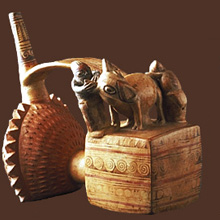
Who
Among the peoples of ancient Peru there was a 4,000 year history of venerating Spondylus shells. The thorny shell of this pink oyster, depicted here on this ceramic whistling bottle, has been found persistently in archaeological contexts such as burials. However, while it has always been important, it was never plentiful until the time of the Lambayeque. The cold waters off Peru's coast do not support the mollusk; however, they thrive in the warmer waters off Ecuador.
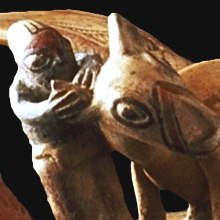
Prior to the time of the Lambayeque, the trade networks required to bring mass quantities of shell from Ecuador to Peru did not exist. Some scholars believe that the founders of the Lambayeque royal dynasty were the first to elevate Spondylus to ritual importance, perhaps ushering in the Chimú kingdom's great demand for the shell.
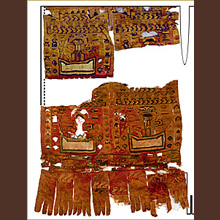
What
Originally, these fragments were part of a tunic. The image on the left shows you the front of a partly reconstructed garment. The complicated imagery on the tunic is a much more difficult puzzle to piece together as it contains many schematic symbols and images whose meaning is known only to the people who created it.
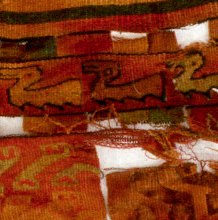
The overall design is a series of repeated seated figures, positioned on some kind of altar or platform. The face is stylized and shown in profile with prominent eyes and teeth. The figure is wearing a classic Lambayeque style feathered crescent headdress. Each figure is bounded by posts and a combed roof, which are meant to indicate an architectural setting for the scene.
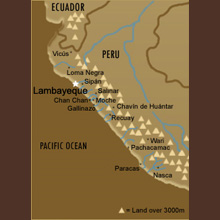
Where
During the Middle Horizon, around A.D. 800, the centralized control held over the north coast by the Moche waned. Politically, much of the region fractured into regional power centres within the various river valleys. In the valleys around the northern Lambayeque River, there is archaeological evidence of a divergent cultural evolution at this time among descendants of the Moche; the people scholars call the Lambayeque.

Legend has it that a hero called Naymlap landed at the Lambayeque valley mouth with a flotilla of balsa rafts. Accompanied by his wife and a large entourage, he claimed he was sent from afar to rule. With the building of a large palatial court he established the Lambayeque dynasty which extended through 12 rulers.